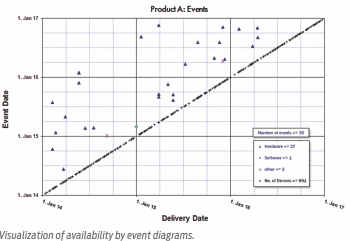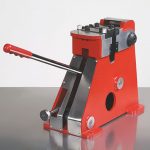ISO 9001 is an international renowned standard in quality management. “The monitoring of the achieved product quality is the prerequisite to meet our customers’ requirements regarding a product or service”, says Arne Heel, Quality Manager at SIKORA AG. In conjunction with the management and employees, he analyzes and records business processes within the company, identifies responsibilities and potential weaknesses. For the visualization of the availability as a key figure of the product quality, SIKORA creates event diagrams to present the device performance and to draw conclusions on the process quality.
Since 1993, SIKORA has been certified according to ISO 9001 and thereby, proves that the quality of the measuring, control, inspection, sorting and analysis technology is ensured by an efficient quality management system (QMS) and is continuously improving. SIKORA’s QMS comprises defined performance indicators in order to monitor and control processes. The availability, for instance, is a figure of a technical system. It is the time value in which the machines and technical measuring devices can be in use without downtime or maintenance. Generally, the intention is to ensure high availability values of a system.
For calculation of the availability, two factors are being considered: Mean Time Between Failures (MTBF) and Mean Time To Repair (MTTR). The first factor, Mean Time Between Failures (MTBF), describes the mean time in which a device can be in use without the need of a repair or downtime for maintenance. With the help of MTBF, the quality progress can be evaluated and it can be monitored how long devices operate without failure.
MTBF is calculated by using the information from SIKORA CRM (Customer Relationship Management): This is where all devices are registered and their events are recorded. CRM also serves as data source for the creation of event diagrams for the different types of devices. The event diagram is a graphical illustration for quick and clear visualization of events and their chronical order. Furthermore, the event diagram provides details concerning the type of individual events for a certain device type.
An event diagram has a horizontal (x) and a vertical (y) timeline. The x-timeline shows the delivery date and the y-timeline shows the event date. The diagram indicates all known downtimes of one device type up until time of creation as shown in the example picture 1 ‘Product A’. Events are being counted, which directly led to a downtime of a device.
Deliveries of all devices are displayed as crosses (1) on the diagonal line of the diagram. On the vertical line above each delivered device its life span can be seen. In event of failure, a certain symbol is noted on the vertical above the device, which gives information about the reason of the failure. In order to display device downtimes, symbols are used for hardware events (Δ), software events (◊) and others (x) (e.g. production errors, faulty deliveries, etc.).
 The event diagram as shown in picture 1 primarily serves to find out, which event types had occurred. It also shows if events of one device occurred immediately after delivery or at a later date. When certain events accumulate to a cluster above a certain delivery date, meaning events, which had not occurred before to this extend, this can indicate that the production process was not controlled well at that time, or else, sourced materials had caused a higher failure rate.
The event diagram as shown in picture 1 primarily serves to find out, which event types had occurred. It also shows if events of one device occurred immediately after delivery or at a later date. When certain events accumulate to a cluster above a certain delivery date, meaning events, which had not occurred before to this extend, this can indicate that the production process was not controlled well at that time, or else, sourced materials had caused a higher failure rate.
Furthermore, event diagrams for certain failure types are created and differentiated according to the different components to collect further details of the device events. This includes, for example, diagrams which are only referring to device events where hardware components contributed to a failure rate. All other failure types (mechanical failures, software failures, etc.) are shown in a separate diagram. In this way, detailed information is given about which component relates to the documented events.
The second factor, which is incorporated into the calculation of the availability, is the Mean Time To Repair (MTTR). This is calculated from the time that is needed to put the device and the system back into operation in the event of failure. Thanks to the quality management and the technical innovations, which render maintenance of SIKORA devices almost unnecessary, very high availability values of up to 99.98 % are reached.
For a continuous quality improvement, internal and external employee training is carried out at SIKORA. Furthermore, cooperations with machine manufacturers as well as customers are established in order to respond to global benchmarks in the trade and to further optimize processes. “A sustainable quality management requires clear, transparent processes and a good communication”, explains Heel. “Feedback from employees and customers in particular are crucial for a successful quality management system”, the Quality Manager explains further. “With the improvement of our operation processes according to the requirements of our QMS, we do not only meet legal standards but also achieve high process reliability and, simultaneously, the highest customer satisfaction”, says Heel.




